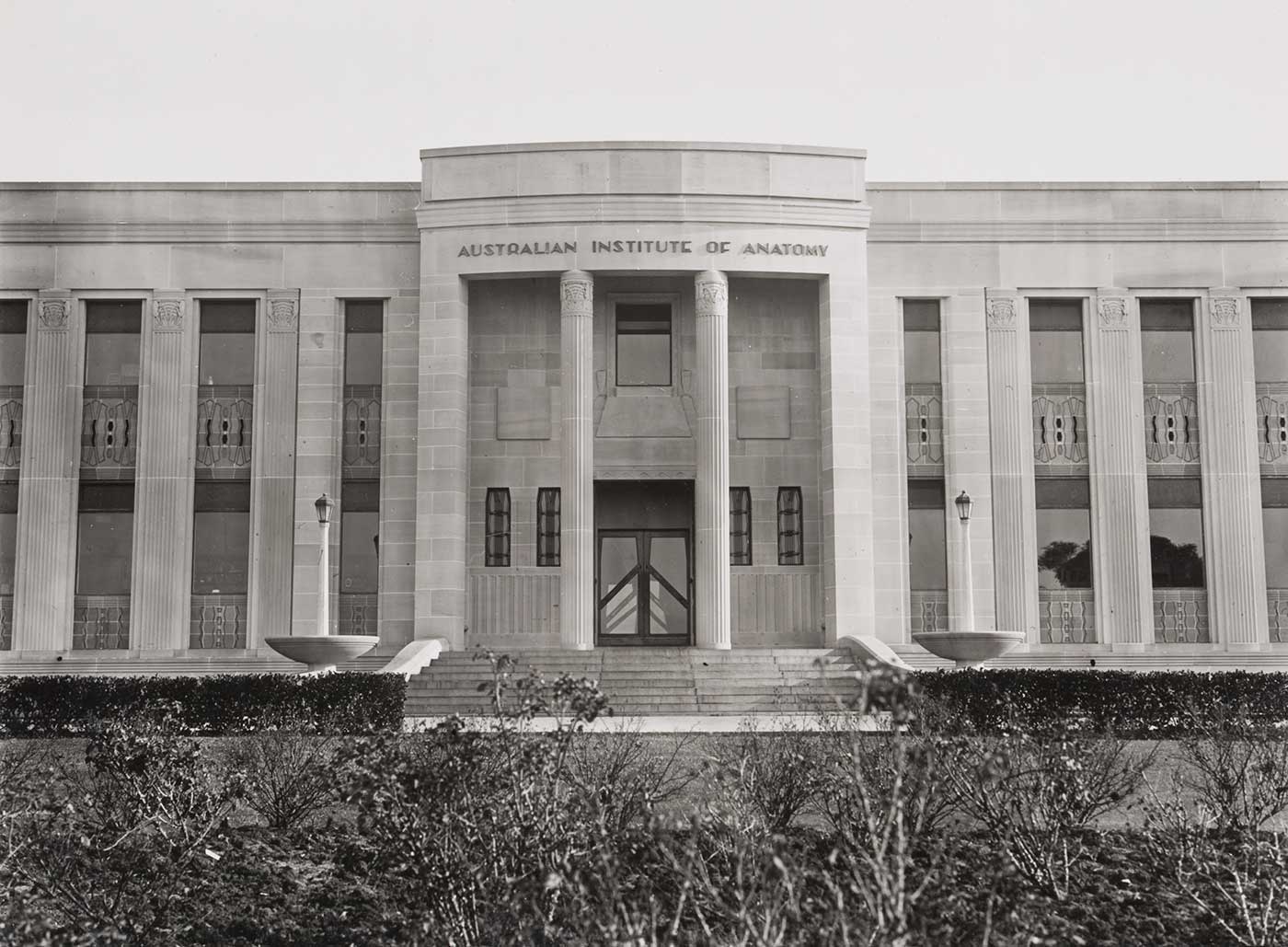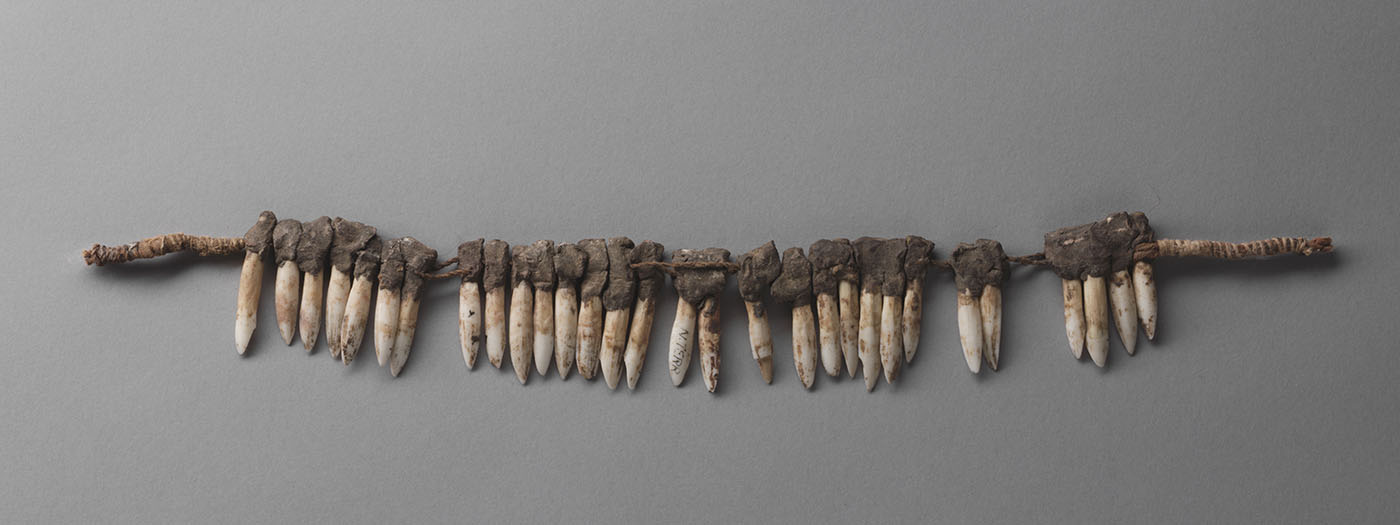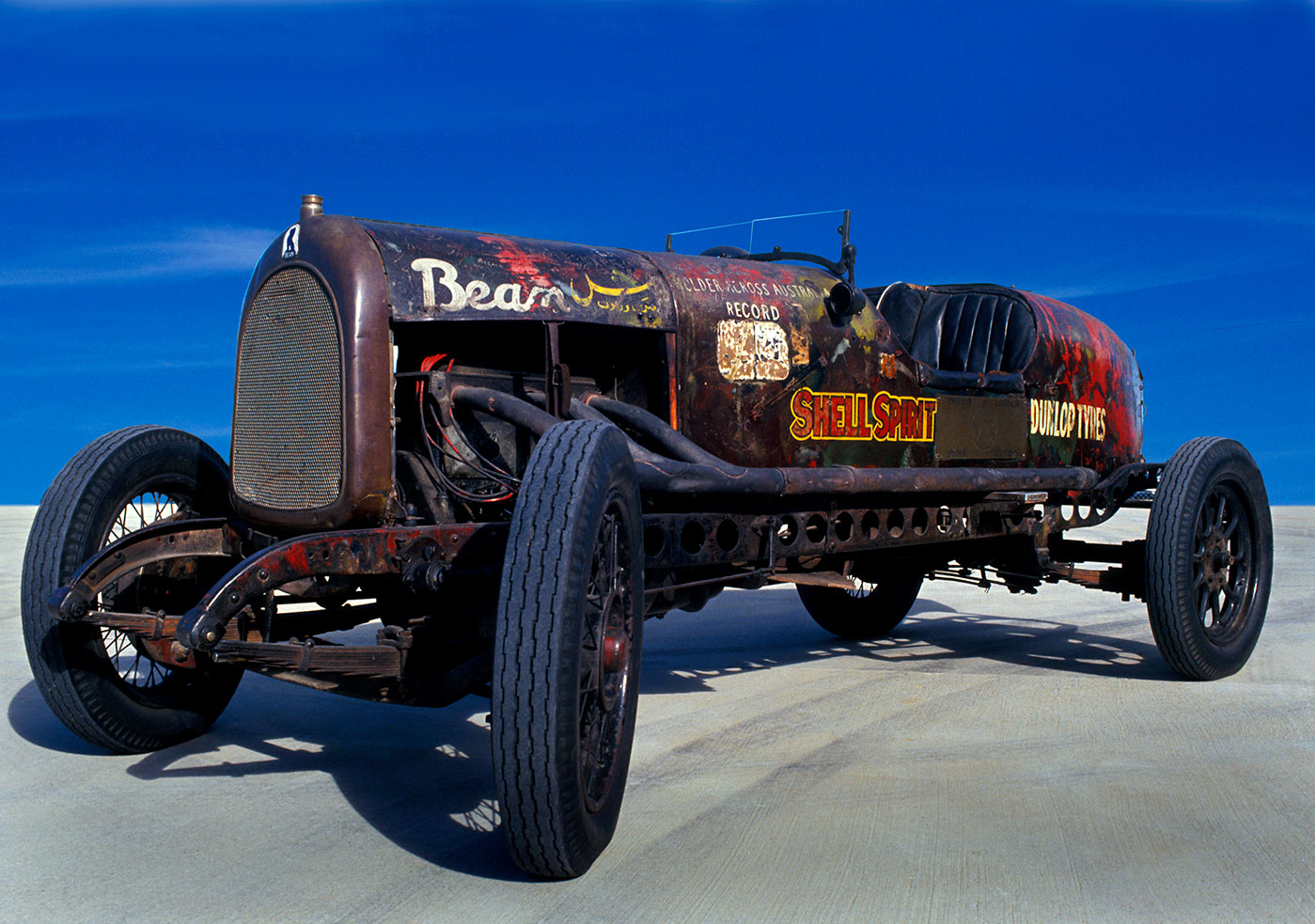by Guy Hansen, Senior Curator, National Museum of Australia, 2006
Colin MacKenzie, first director of the National Museum of Australian Zoology, 1924:
In order that our own fauna will not be lost to science the Federal Government has established the National Museum of Australian Zoology and has allotted sites for the Museum buildings and Research reservations at Canberra, which will become the world's centre for the study of our fauna and comparative anatomy.
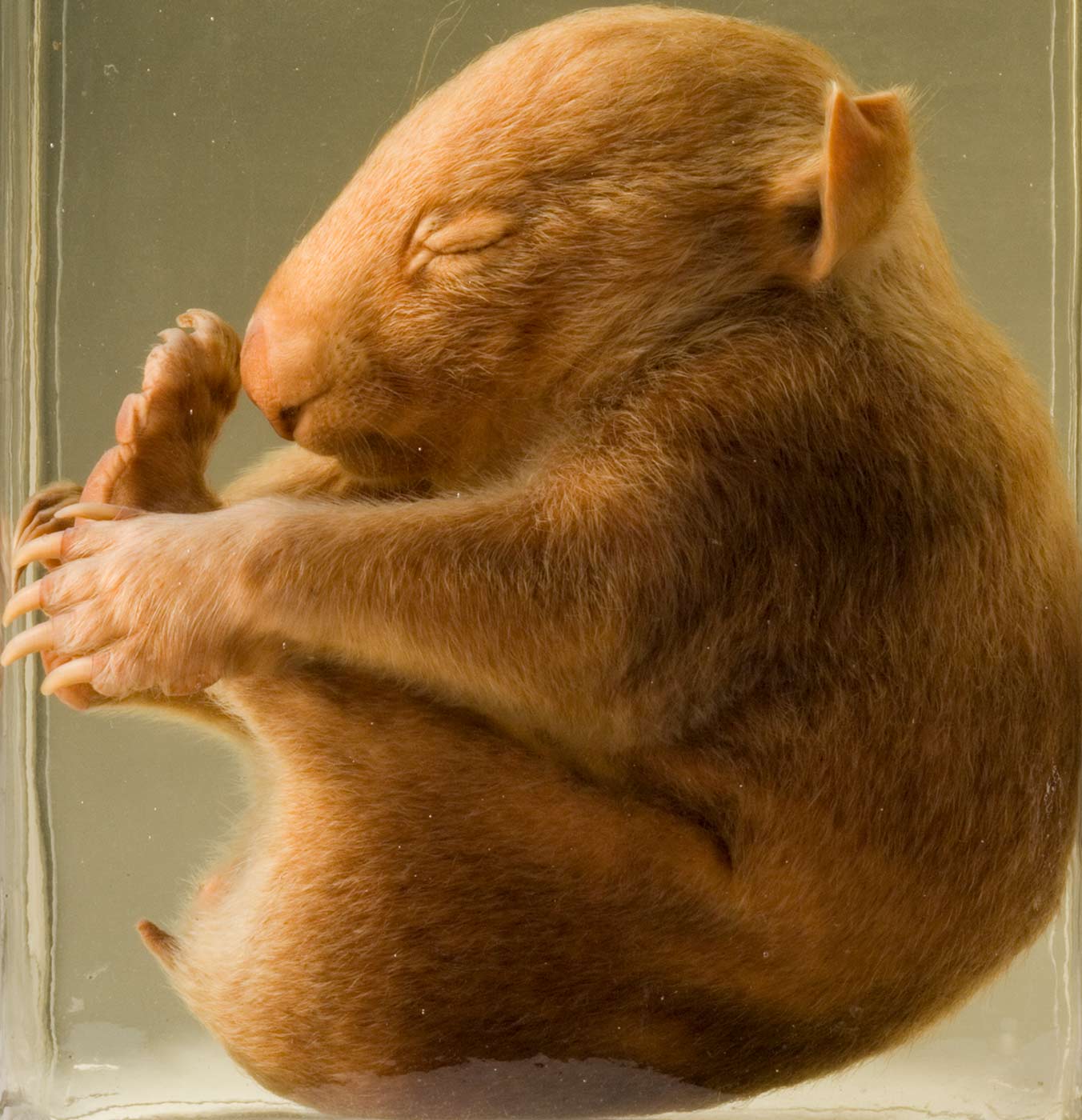
The idea of an Australian national museum predates Federation. Institutions such as the Australian Museum and the National Museum of Victoria represent early attempts to build collections encompassing the flora, fauna, geology and Indigenous cultures of the continent. Australia’s first truly national museum, however, was born of the vision of Colin MacKenzie.
MacKenzie, a prominent Melbourne orthopaedic surgeon, believed that Australia’s unique fauna was destined for extinction. In 1924 he wrote, ‘Unfortunately these animals are fast disappearing, and, in less than 20 years it is computed, will, in the absence of rigid protective measures, be all extinct.'
Australian animals
A man of considerable wealth and extensive political connections, MacKenzie devoted much of his professional life to building an extensive collection of Australian animal specimens. This collection was later to become the National Museum of Australia’s first collection.
MacKenzie viewed Australian marsupials and monotremes as important, not just as examples of endangered species, but also for their potential to provide insights into the treatment of disease. The complexities of the human body, he argued, could, ‘only be revealed by a study of types of animals in which these can be demonstrated in their simpler form’.
Australian animals were unique, providing a rich field of comparative examples that could be used to better understand human anatomy. MacKenzie’s study of koalas reflects this argument. He observed koalas possessed a hyper-extensiveness in their arms, allowing them to grasp gum leaves above their heads. Using detailed dissections of koala shoulders he was able to design a shoulder splint as a treatment for sufferers of infantile paralysis.
The splint held the arm out from the side of the chest, helping to re-educate damaged muscles. MacKenzie was later able to adapt this technique when working as a surgeon at the Military Orthopaedic Hospital in Shepherd’s Bush, London, during the First World War. Here the splint technique was used to treat soldiers with wounds to their upper limbs.
These practical applications convinced MacKenzie of the usefulness of comparative anatomy in the development of treatments for injury and disease, and confirmed him in his belief that it was vital to preserve and study Australian animals.
In 1919, at his own expense, he opened a laboratory and museum in Melbourne which he named the Australian Institute of Anatomical Research. Working with a number of assistants including the artist Victor Cobb, MacKenzie began building a collection of preserved specimens of Australian wildlife.
This work gathered pace in the 1920s when the Victorian Government allowed him to establish a field research station at Badger Creek, Healesville. This reserve gave him the capacity to breed and collect native animals for use as anatomical specimens.
Fauna and nationalism
MacKenzie’s interest in Australian fauna reflected a strong sense of nationalism. He believed in the uniqueness of the Australian environment and his desire to collect was, in part, an expression of pride in Australia.
This sense of patriotism was combined with a social Darwinist world view which saw humans at the apex of evolutionary development. As MacKenzie described it, ‘man is distinguished from all other animals by the fact that he stands and walks on the two hind or lower limbs leaving the fore or upper limbs free’.
For MacKenzie, this erect posture was the basis of human intelligence. In a strange twist he believed that Australians were unusually blessed in this regard: Australian football as an exercise, he argued, was more conducive to erect posture than almost any other game in the world! ‘It is founded on sound physiological lines and has been a no small factor in the physical development of our nation,' he wrote.
Australian Institute of Anatomy
MacKenzie, convinced of the national significance of his work, offered his collection of specimens to the Australian Government. The collection consisted of approximately 2000 items, including a variety of wet and mounted specimens and anatomical drawings completed by the artist Victor Cobb.
The government responded to MacKenzie’s generous offer by creating the National Museum of Australian Zoology in 1924. MacKenzie was appointed the Museum’s first director and in 1929 received a knighthood in recognition for his contribution to medical research.
In 1931 the Museum of Australian Zoology changed its name to the Australian Institute of Anatomy to coincide with the opening of its Canberra home. The new title reflected MacKenzie’s goal of creating a major research facility focusing on comparative anatomy. The building which housed the institute was one of the first major public buildings in Canberra and is today the home of the National Film and Sound Archive.
Sadly, MacKenzie’s dire prediction of extinction proved to be true for many Australian animals. His collection includes examples of both rare and endangered species. Perhaps one of the most significant specimens is a whole carcass of a thylacine. This is believed to be the only complete adult thylacine carcass preserved in the world.
Paradoxically, however, MacKenzie’s focus on the anatomical attributes of his specimens reduced their significance from a zoological perspective. MacKenzie did not keep detailed records showing the sub-species, dissector, and location or origin of each specimen.
Rather, the specimens were labelled with a brief description of the organ preserved, and the common name of the animal. Although the individual provenance is lacking, many specimens are invaluable due to their rarity.
Platypus
During his time as director of the institute, MacKenzie acquired specimens from major collectors around Australia. The most important of these is the Burrell collection of platypus material. This includes a series of specimens illustrating the development of the platypus from egg to adult.
Harry Burrell was a self-taught naturalist whose research provided the first detailed accounts of the life history and habits of the platypus. He was perhaps most famous for his success in keeping and exhibiting live animals in a specially built tank known as a ‘platypusary’.
One of the first platypuses to be kept in this way was ‘Splash’, who survived for four years at MacKenzie’s Healesville sanctuary. Curiosity about this mysterious animal was such that Splas5h quickly became a tourist attraction. Newspaper articles described him as ‘the world’s most famous platypus’.
After his death, Splash’s body was sent to Canberra for mounting. Institute of Anatomy records suggest the mounted platypus was later presented to Winston Churchill as a gift from the Australian people.
Phar Lap's heart
The most famous of all the Institute of Anatomy’s collection of specimens was
Two years later Australia was stunned at the news of the horse’s death under suspicious circumstances in the United States. Phar Lap’s remains were dispersed across the globe with the mounted hide going to the National Museum of Victoria, the skeleton to the National Museum of New Zealand and the heart to the Australian Institute of Anatomy.
Displayed for many years at the Institute of Anatomy next to the smaller heart of another horse, the Phar Lap specimen was a visual confirmation of the Australian saying, ‘a heart as big as Phar Lap’s’.
The Institute of Anatomy also had major holdings of human remains. A large collection of ‘war wounds’ assembled by the Hunterian Museum of the Royal College of Surgeons of England, was sent to the Institute in 1935. In 1996 this collection was transferred to the Australian War Memorial which subsequently loaned it to the Department of Forensic Science at the University of New South Wales.
In our collection
National Ethnographic collection
The Institute of Anatomy also held large collections of Indigenous remains including material collected by George Murray Black, a civil engineer and pastoralist with property in western Gippsland.
During the 1930s, Black collected skeletons from Aboriginal cemeteries on behalf of the institute. This material was taken without permission and was effectively a form of graverobbing.
Today, the National Museum of Australia does not collect human skeletal material and has been returning human remains to Indigenous communities for more than 20 years.
In addition to storing and exhibiting MacKenzie’s anatomical specimens, the Australian Institute of Anatomy also cared for the National Ethnographic collection. This was a diverse set of objects totalling over 20,000 items.
The material was collected by some of Australia’s earliest collectors of Aboriginal and Pacific material. This material later provided the basis of the National Museum’s Aboriginal and Torres Strait Islander collections, today considered one the best collections of Indigenous material in the world.
The National Ethnographic collection began when MacKenzie accepted a number of significant ethnographic collections accumulated both by professional and amateur collectors. At first glance his acquisition of these collections sits awkwardly with his interest in comparative anatomy.
For MacKenzie, however, there was a close link between the fate of Australian fauna and Aboriginal people. MacKenzie saw a parallel between the impact of settlement on wildlife and declining numbers of Indigenous people.
As he described it, ‘Thanks to poison and the gun they are rapidly following the fate of the Tasmanian nation which was completely destroyed in a period of about 40 years, constituting the most colossal crime our earth has known.’
Tasmania had come to symbolise a microcosm of what could happen on the mainland. While perhaps distasteful to modern sensibilities, MacKenzie’s conflation of Aboriginal people with Australian fauna was a major motivating factor in his desire to collect Indigenous material.
One of the first ethnographic collections acquired by the Institute of Anatomy was the George Horne collection. A gynaecologist by training, Horne was passionately interested in ornithology and ethnology.
In the early 1920s, he made two extended trips to central Australia to pursue his interest in Aboriginal culture. He collaborated with George Aiston to produce the book Savage Life in Central Australia, published in 1924.
Like many collectors of the period, Horne was mainly interested in men’s objects, especially weapons. Of the 439 objects in his collection, 336 were primarily used by men. Horne and Aiston saw culture in evolutionary terms, placing artefacts in a hierarchy of what they perceived to be most primitive to most advanced.
This is reflected in one of the photographic plates from Savage Life in Central Australia, in which a series of weapons are displayed as an evolutionary sequence of boomerang design. Horne’s and Aiston’s taxonomy of the development of the boomerang illustrates how evolutionary ideas played themselves out in terms of analysing Indigenous material culture.
Indigenous artefacts
Another major early collector whose material was deposited in the Institute of Anatomy was Edmund Milne. Milne, an assistant commissioner in the New South Wales Railways, collected Indigenous material from the 1870s through to the 1910s. Milne’s work on the railways took him around the state, enabling him to meet Aboriginal people and build a major collection of artefacts.
He displayed his collection in his home, arranging items by their type and size. He also gave public lectures on the ‘Australian stone age’, emphasising the importance and value of Aboriginal culture. He bequeathed his collection to ‘the first Federal Museum opened in the Federal Capital’.
Other important acquisitions of ethnographic material followed, including
Between 1903 and 1928 Basedow, who in addition to being an anthropologist was a medical doctor and geologist, took part in many expeditions to central and northern Australia. While these expeditions were primarily organised to conduct surveys of the health of Aboriginal communities and to survey potential mineral resources, Basedow always took the opportunity to collect objects and record field observations concerning Aboriginal culture.
An important subset of the National Ethnographic collection is a range of field work collections sourced from Sydney University. These collections were made by anthropologists working in the late 1920s and 1930s.
Part of their significance stems from the fact that Sydney University was the first Australian university to establish an anthropology department. AR Radcliffe-Brown and AP Elkin were leading figures in the department, encouraging students to undertake fieldwork across Australia including Cape York, Arnhem Land, central Australia, the Kimberley and Bathurst Island. Much of this fieldwork was funded by the Rockefeller Foundation of America.
Artefacts collected on these field trips are now held by the National Museum of Australia, the Macleay Museum in Sydney and several museums overseas.
In our collection
Pacific Islands
In addition to Aboriginal material, the National Ethnographic collection also included examples of Pacific material culture. This was material collected by officials during the period of Australia’s administration of Papua in the early 20th century.
These collections are known as the Official Papuan collection. Originally intended for a Papuan museum, the collections were sent for safekeeping to the Australian Museum in Sydney. They were then sent to the Australian Institute of Anatomy in 1934.
Objects in the Official Papuan collection include material collected by FE Williams who served as government anthropologist in Papua from 1922 to 1943.
The Institute of Anatomy continued acquiring ethnographic material after the retirement of MacKenzie in 1937. This was partly because of the historical precedent MacKenzie established, but also for the pragmatic reason that there was no other Commonwealth institution in which to store this material. The Institute of Anatomy had become, almost by default, home to these collections.
A good example of a collection acquired in this way was the material collected under the auspices of the American-Australian Expedition to Arnhem Land in 1948. This was a multidisciplinary expedition which set out to explore the Aboriginal culture and natural history of Arnhem Land.
Objects collected were distributed between American and Australian institutions. The expedition helped change perceptions of Aboriginal paintings, encouraging people to view them as art rather than simply as ethnographic objects.
The Institute of Anatomy also stored collections on behalf of the Australian Institute of Aboriginal Studies (AIAS). AIAS was created in 1961 with the aim of promoting research into Indigenous culture. It funded fieldwork around Australia and purchased significant collections of Indigenous material.
One of its major areas of material culture collecting was bark paintings, resulting in one of the largest collections of barks in the world. Collections acquired by AIAS were mainly sourced from Northern Australia.
In 1989 AIAS was reformed as the Australian Institute of Aboriginal and Torres Strait Islander Studies (AIATSIS) and is now collocated on Acton Peninsula with the National Museum of Australia.
Historical collections
By the early 1970s the Institute of Anatomy was responsible for MacKenzie’s anatomy collection as well as the National Ethnographic collection. These were the building blocks of what would eventually become the National Museum of Australia’s collection.
In addition to the Institute of Anatomy, historical material was also held by a range of other government departments. For example the Department of Home Affairs, the Department of Transport, the Bureau of Mineral Resources, the Australian Broadcasting Commission and the Department of the Capital Territory all held significant collections.
Much of this material was kept with a view to it eventually being transferred to a museum. Among these collections were such items as the Australian Broadcasting Corporation’s first outside broadcast van and the Ranken coach, the oldest horsedrawn vehicle in Australia.
There were also items donated by private citizens, such as the Bean 14 car driven by Francis Birtles from Darwin to Melbourne in 1926 and from London to Melbourne in 1927. Birtles presented this car to the Australian Government in 1929 in anticipation of a national museum being built in Canberra.
Maritime archaeology was another source of historical material for the Australian Government. In the late 1960s and early 1970s some important maritime objects were recovered from the sea bed. This included a number of cannon and an anchor from Cook’s Endeavour. These were located in 1969, when researchers, using Cook’s charts, searched the area of the reef where the Endeavour ran aground in 1770.
Cook had jettisoned these objects to lighten his ship. In 1972 divers also recovered two anchors from Goose Island Bay of the coast of Western Australia. These were the anchors that Mathew Flinders had cut loose from his ship the Investigator in 1803.
National Museum of Australia
In 1974 concern about the preservation of historical material saw the Australian Government establish an inquiry into museums and national collections. This inquiry, which came to be known as the Pigott report after its chair Peter Pigott, delivered its findings in 1975.
The report concluded that the ‘deterioration of valuable collections in Australian museums, great and small, has reached the proportion of a crisis’. The report’s central recommendation was that a ‘Museum of Australia be established in Canberra’.
The proposal for the creation of a national museum was well received on both sides of politics. In 1980 the National Museum of Australia Act was passed with bipartisan support. The key function of the Museum would be to ‘develop and maintain a national collection of historical material’.
This collection would be known as the National Historical Collection. Minister for Home Affairs, Bob Ellicott, described the three main themes of the Museum as ‘the history of Aboriginal Man, the history of non-Aboriginal man and the interaction of man with his environment’.
The first collections to be absorbed by the National Historical Collection were the MacKenzie collection and the National Ethnographic collection. The Museum’s legislation specifically made provision for the transfer of these collections from the Institute of Anatomy.
The Act also allowed for collections held by other Commonwealth bodies to be transferred as required. Over the 1980s and 1990s the Museum accepted transfers of historical material from several government departments, including the Australian Broadcasting Commission, Australia Post, CSIRO, and the Bureau of Mineral Resources.
In this way the Museum was able to rapidly consolidate a number of existing Commonwealth collections to provide the core the National Historical Collection.
In addition to these government collections, the Museum began acquiring material in its own right. This included donations from the general public, purchases at auction and targeted collecting projects.
In the 1980s social history was the dominant theoretical model for exploring history in museums. Museums such as the Powerhouse, Hyde Park Barracks and Museum of Victoria were the major exponents of this approach in Australia. Collections were built around themes such as working life, domestic life and leisure. This was reflected at the National Museum of Australia in the acquisition of collections documenting iconic Australian consumer items such as the Victa lawnmower and Hills hoist.
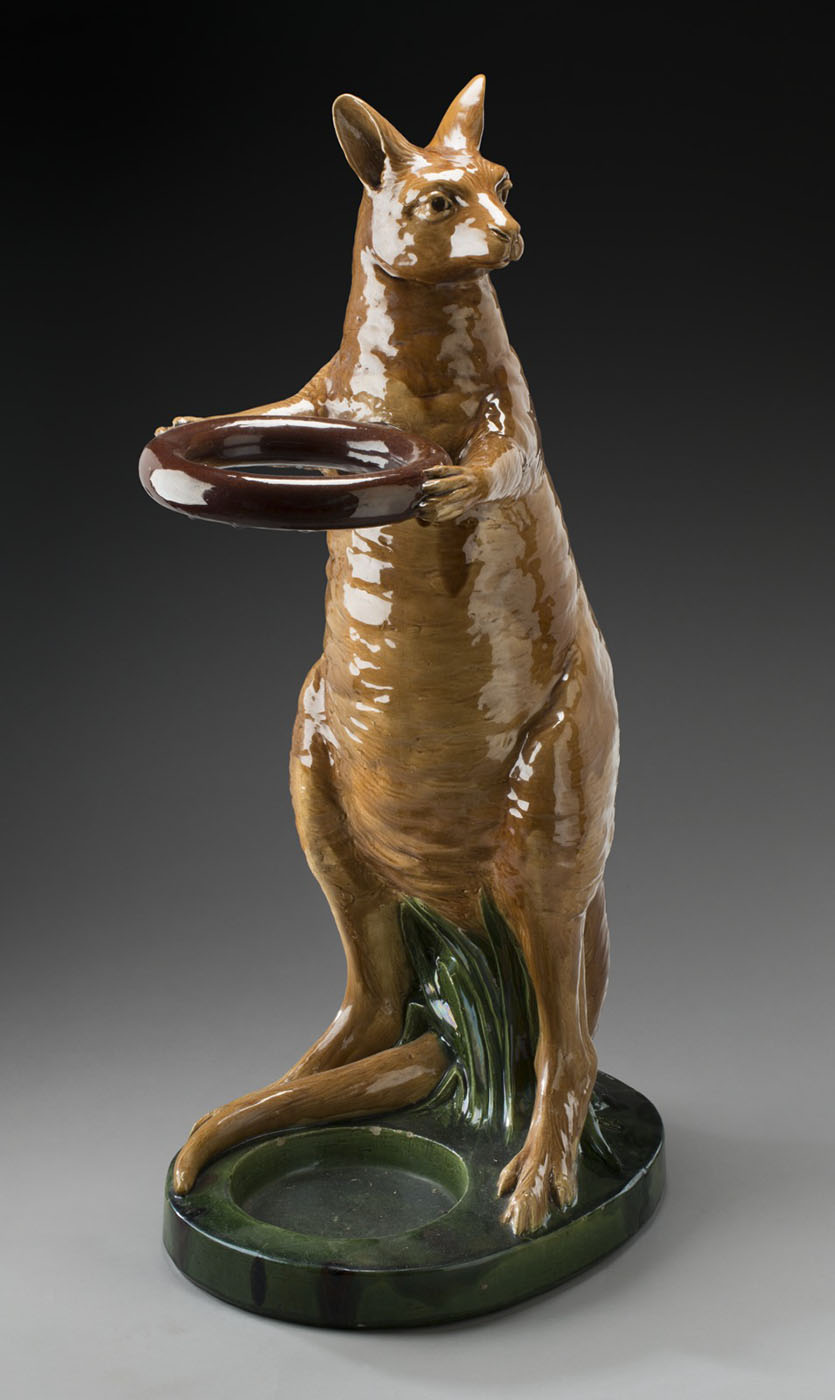
The Museum also launched a major appeal for migrant material, resulting in a strong set of collections exploring the experience of postwar European migrants.
In the mid-1980s the Museum took the opportunity to purchase components of some major museum collections which were in the process of being dispersed. This included the Wetzel Movie Museum (material relating to the history of film and television in Australia) and the Bothwell Museum (social history material from Tasmania).
The Museum also collected a range of large-technology items, including agricultural machinery, motor vehicles, printing presses, horse-drawn vehicles, steam engines and aeroplanes. One prized object is the paddle steamer Enterprise, which was acquired in 1984 and, after extensive restoration at Echuca, was formally recommissioned on Lake Burley Griffin in 1988.
The National Museum of Australia has also acquired a number of collections that reflect the work of individual collectors. The Josef Lebovic collection of postcards, the Terry Lane collection of Australian decorative arts and the Cecil Ballard collection of royal memorabilia are excellent examples of the passion of the committed collector.
These collections, which were the result of years of effort on the part of an individual, provided a very effective means for the Museum to build high quality collections quickly.
Environmental history
One of the Museum’s key themes, human interaction with the environment, has been the focus of several targeted collecting projects. This has resulted in significant collections concerning the history of the Murray–Darling Basin, the impact of introduced species, salinity in the Murray–Darling basin, and the history of bushwalking.
One major acquisition on permanent display is the ‘buffalo catcher’. This vehicle is fitted with a special bionic arm and was used for catching buffalo in the Northern Territory in the 1980s. This is a powerful object for exploring one of the largest and most successful feral animal eradication programs in Australia’s history.
In our collection
Major collecting areas
Political history is another major collecting area for the Museum. Collections include material relating to key politicians, protest material, political ephemera and objects relating to Federation.
Personal possessions of Sir Robert Menzies are held alongside trade union banners, campaign material and ephemera associated with the opening of Parliament House. One popular collection is the Museum’s holdings of political cartoons, which provide a wonderful visual archive of Australian history.
Indigenous Australia has remained a major collecting area. One of the most significant recent acquisitions is the Aboriginal Arts Board collection which was transferred to the Museum in the mid-1990s.
The Aboriginal Arts Board was very influential in developing an awareness and appreciation of Indigenous art nationally and internationally in the 1980s. This collection includes a significant amount of material from Western Desert communities, including large canvases from the Papunya Tula art movement.
In recent years the Museum has built one of the largest collections of king plates in the world. These brass plates, which were awarded to Aboriginal people in the 19th and early 20th centuries, are an important resource for the study of contact history.
Today, 25 years after the passing of the National Museum of Australia Act, the National Historical Collection has grown in size to over 200,000 items. The collection is not the result of a single hand, but rather reflects many people’s efforts in preserving material for future generations of Australians. MacKenzie’s original vision of creating a collection of anatomical specimens was the first step in building these collections.
Reviewing the National Historical Collection reveals a number of collecting impulses ranging from a desire to preserve a record of Australia’s flora and fauna through to pride in an emerging nation. With the establishment of the National Museum of Australia in 1980, these objects found a permanent home.
Stored and cared for, exhibited and researched, the National Historical Collection is a rich and unique archive of Australia’s history and culture.
References
Committee of Inquiry on Museums and National Collections, Museums in Australia 1975: Report of the Committee of Inquiry on Museums and National Collections including the report of the Planning Committee on the Gallery of Aboriginal Australia, Canberra, AGPS, 1975.
House of Representatives Hansard, 2 April 1980.
David Kaus, ‘Collecting by Railway: The Milne Collection of Ethnology’, unpublished masters thesis, University of Canberra, Canberra, 1998, p.63.
Colin MacKenzie, ‘The Importance of Zoology to Medical Science’, Presidential Address, Australian Institute of Anatomy 1928.
Colin MacKenzie, ‘The Medical Importance of the Native Animals of Australia’, paper circulated for the information of Honourable Members by the Honourable the Chief Secretary, MacKenzie papers, National Museum of Australia.
Explore more Captivating and Curious
You may also like
